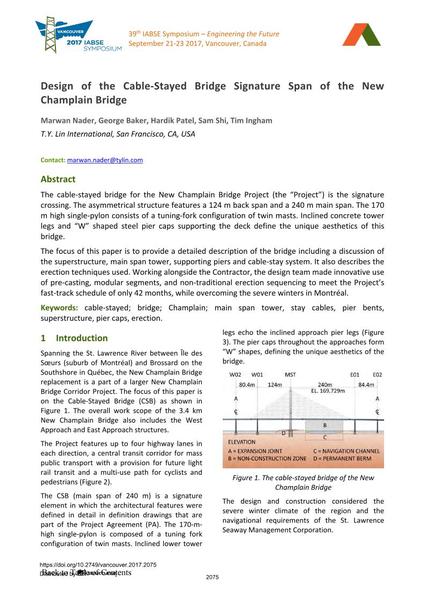Design of the Cable-Stayed Bridge Signature Span of the New Champlain Bridge

|
|
|||||||||||
Détails bibliographiques
| Auteur(s): |
Marwan Nader
(T.Y. Lin International, San Francisco, CA, USA)
George Baker (T.Y. Lin International, San Francisco, CA, USA) Hardik Patel (T.Y. Lin International, San Francisco, CA, USA) Sam Shi (T.Y. Lin International, San Francisco, CA, USA) Tim Ingham (T.Y. Lin International, San Francisco, CA, USA) |
||||
|---|---|---|---|---|---|
| Médium: | papier de conférence | ||||
| Langue(s): | anglais | ||||
| Conférence: | IABSE Symposium: Engineering the Future, Vancouver, Canada, 21-23 September 2017 | ||||
| Publié dans: | IABSE Symposium Vancouver 2017 | ||||
|
|||||
| Page(s): | 2075-2082 | ||||
| Nombre total de pages (du PDF): | 8 | ||||
| Année: | 2017 | ||||
| DOI: | 10.2749/vancouver.2017.2075 | ||||
| Abstrait: |
The cable-stayed bridge for the New Champlain Bridge Project (the “Project”) is the signature crossing. The asymmetrical structure features a 124 m back span and a 240 m main span. The 170 m high single-pylon consists of a tuning-fork configuration of twin masts. Inclined concrete tower legs and “W” shaped steel pier caps supporting the deck define the unique aesthetics of this bridge. The focus of this paper is to provide a detailed description of the bridge including a discussion of the superstructure, main span tower, supporting piers and cable-stay system. It also describes the erection techniques used. Working alongside the Contractor, the design team made innovative use of pre-casting, modular segments, and non-traditional erection sequencing to meet the Project’s fast-track schedule of only 42 months, while overcoming the severe winters in Montréal. |
||||
| Mots-clé: |
pont superstructure haubans
|
||||
